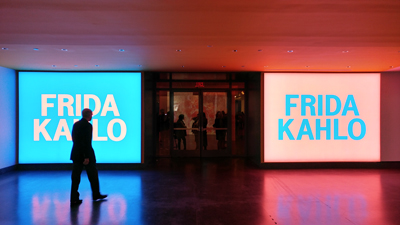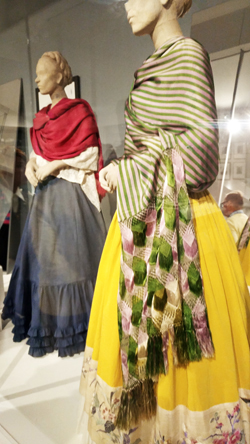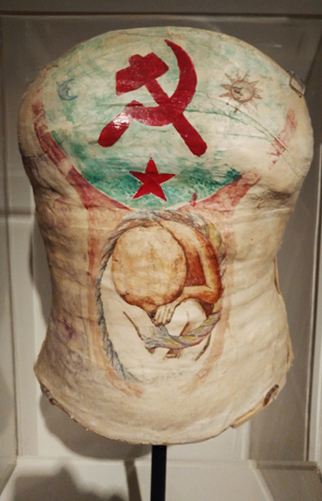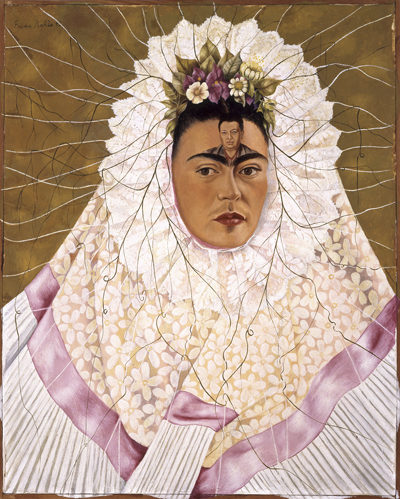Art Review: Frida Kahlo: Appearances Can Be Deceiving
Brooklyn Museum, February 8 to May 12, 2019
By Mark Laiosa
arttimesjournal February 20, 2019
 Entrance to Brooklyn Museum's Frida Kahlo: Appearances can be Deceiving exhibition |
The Brooklyn Museum has launched an all-out marketing push of the Frida Kahlo exhibit, the expected public programs of concerts and curator talks are joined by a ¡Viva Frida Kahlo Dance Party! Including a Revlon makeup station (Kahlo's lipstick of choice and presenter of the exhibit), with hopes of bringing an audience that might not be museum goers. Kahlo's persona does invite people to play. The Dallas Museum of Art celebrated Kahlo's 110th birthday in 2017 with a Frida Fest. Attendees dressed as Frida earned an entry into the Guinness Book of World Records for the largest number of people dressed as Kahlo. Brooklyn Museum's on-site restaurant, The Norm, is taking part in the exhibition, painting one of their walls a "soft salmon" to match the exhibition walls to display the works of Carlos Mendez, painter and former assistant to Frida's husband, Diego Rivera. The menu will be featuring Mexican inspired dishes and Mexican themed drinks. Guest chefs for the run of show will be cooking a lively menu.
Bright colored translucent panels on the revolving doors are a warm-up to the exhibition with large back-lit entrance panels with "Frida Kahlo" in capital letters that opens into a gallery of paintings, clothing, assorted objects, and looping film clips. The wall text is in English and Spanish.
 Traditional Tehuana clothing, Casa Azul |
This massive exhibit of Kahlo's life and work is based on earlier exhibitions, one curated by Circe Henestrosa at the Frida Kahlo Museum, also known as the Casa Azul or Blue house in Mexico City. She later partnered with Claire Wilcox and curatorial advisor Gannit Ankori at London's Victor and Albert Museum. Senior curators Catherine Morris and Lisa Small tapped into the Brooklyn Museum's collections, adding works that gave additional context.
Kahlo's life and works are presented in ten thematic groups totaling approximately 300 items, among them, eleven paintings and fifteen drawings, clothing, and photographs. It is the first time attendees in the US are seeing Kahlo's personal items, cosmetics and clothing from the Blue House.
After Kahlo's death in 1954, Rivera had the house sealed with instructions to open it fifteen years after his death. Rivera died in 1957 and the house was opened in 1972 with an inventory of personal items completed in 2004.
In the section labeled "Roots," expected to see the "Roots" painting of Kahlo laying on her side, like an open pea pod, vines coming out and into the soil, instead, black and white portrait photographs taken by her photographer father Guillermo Kahlo, a German-Hungarian immigrant, and images of her Spanish-Tehuana mother, Matilde Calderon y Gonzalez with family members around the Blue House, the site of Frida Kahlo's birth, death, and grave.
The Gringolandia section exhibits artifacts and photos of Frida in New York City. In one color photograph, Kahlo is dressed in a bold red top and bright blue skirt with a white hem, a sharp contrast to the drab surroundings of a Greenwich Village rooftop; excerpts from her journal expressing her ambivalence towards American culture and the gap between classes is also shown. Kahlo's only New York exhibit was in 1938 at New York's Julien Levy Gallery and a success, helping establish her international fame, a sign of the times, the exhibition invitation has Frida Kahlo (Frida Rivera).
 Plaster Corset, circa 1960 Plaster & mixed media, Private Collection. |
The Art and Revolution section displays her reaction to the gulf between classes in American society and the Mexican Revolution bolstering her belief in Communism that manifests itself in several of her works. On display is a plaster corset, one of many she was placed in after surgery, with a vermillion hammer and sickle painted with a light blue sky and stylized sun on its chest with a fetus in light brown painted below, perhaps her vision of better days for the future under communism.
Diego Rivera and Kahlo managed to get asylum for Leon Trotsky and his wife. A film clip of the foursome is part of the exhibition and adds another dimension to these historical figures.
Her relationship with Rivera was complex; they married in 1929. Kahlo showed her feelings towards Rivera in the painting "Self-portrait as a Tehuana," her face framed by a Tehuana head piece, with a small painting of Diego on her forehead, just above her unibrow (beautifully lit, as are all the paintings.) They were divorced in 1939 and remarried in 1940.
Kahlo pushed boundaries by wearing men's clothing and exploring her sexuality. Kahlo strongly identified with Tehuana culture and several sets of dresses and tops are on display. She embraced her culture and collected meso-American sculptures that the Brooklyn Museum matched with several items from the Arts of America Collection, including West Mexican ceramics, and figurines from Aztec and Nayarit cultures showing the connection to Mexico's past.
 |
Frida survived polio as a child with a limp and had plans to attend medical school; a bus accident changed the direction of her life. Many surgeries and long periods of convalescence was the focus of much of her work. Frida's canvas was the world around her. She painted or customized her everyday items, from her prosthetic leg and matching shoe, to several of her post-surgical plaster corsets.
Her wardrobe of traditional Tehuana clothing -loose fitting tops, shawls, and voluminous skirts- masked her damaged body and pain while drawing attention to herself. She enjoyed crafting a personal style that is called by some now a days, "branding," and looking good for the camera, as portraits by Nickolas Muray and Edward Weston showing that appearances can be deceiving.
Frida Kahlo: Appearances Can Be Deceiving is on view at the Brooklyn Museum untill May 12, 2019. More information at www.brooklynmuseum.org/exhibitions/frida_kahlo
Frida Kahlo Self-Portrait as a Tehuana, 1943. Oil on hardboard, 30 x 24 in. (76 x 61 cm). The Jacques and Natasha Gelman Collection of 20th Century Mexican Art and the Vergel Foundation. © 2019 Banco de México Diego Rivera Frida Kahlo Museums Trust, Mexico, D.F. / Artists Rights Society (ARS), New York
